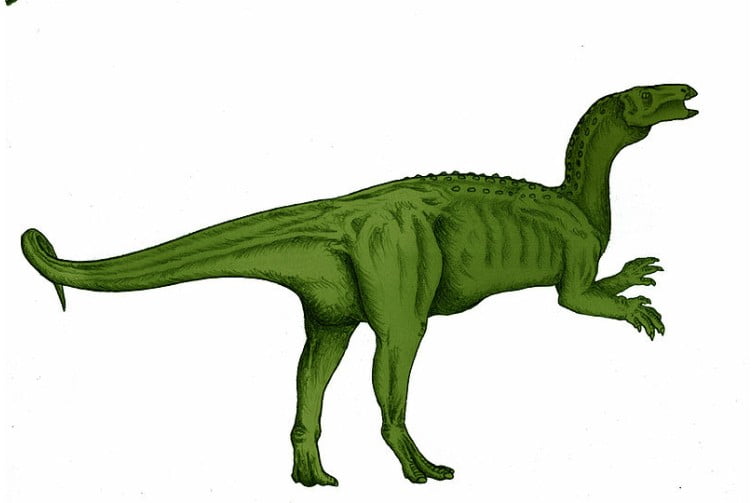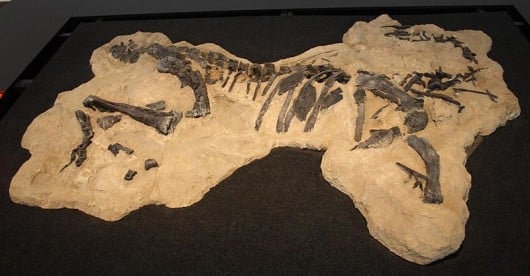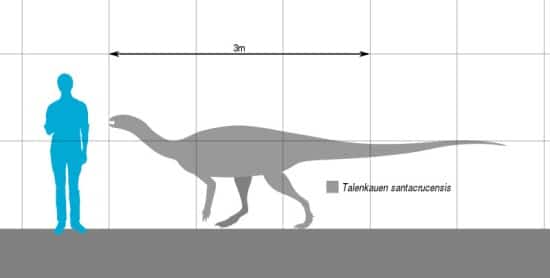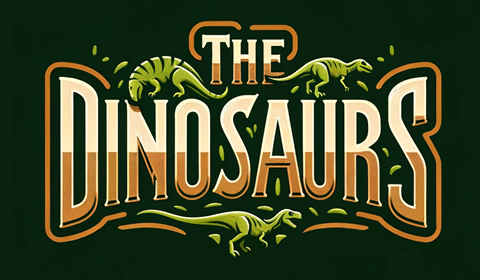Among the ancient giants was a rather intriguing dinosaur, Talenkauen, whose remains tell a fascinating story. Discovered in the windswept expanses of Patagonia, this herbivorous dinosaur offers a unique glimpse into a world long gone. Its name, derived from the Aonikenk language, means “small skull,” a humble moniker for a creature that lived during the majestic Late Cretaceous Period.
Talenkauen Key Facts
| Keyword | Fact |
|---|---|
| Pronunciation | ta-len-ka-wen |
| Meaning of name | Small skull |
| Group | Ornithischia: Iguanodontia4 |
| Type Species | Talenkauen santacrucensis |
| Diet | Herbivore |
| When it Lived | 93.9 to 89.8 MYA |
| Period | Late Cretaceous |
| Epoch | Turonian |
| Length | 13.0 to 15.0 feet |
| Height | 6.5 feet |
| Weight | 660 lbs |
| Mobility | Moved on two legs |
| First Discovery | 2000 by Fernando Novas and team |
| Location of first find | Mata Amarilla Formation, Santa Cruz Province, Argentina |
| First Described by | 2004 by Fernando Novas, Andrea Veronica Cambiaso and Alfredo Ambrosio |
| Holotype | MPM–10001A |
Talenkauen Origins, Taxonomy and Timeline
Talenkauen, a name that resonates with the echoes of Patagonia, means “small skull” in Aonikenk language. The specific name, santacrucensis, pays homage to the province where it was found. The taxonomy of this fascinating creature places it within the Ornithopoda group, a diverse family of bipedal herbivores. Specifically, it belongs to the Euiguanodontia (Ornithopoda: Iguanodontia) and is the type species of the genus Talenkauen, known as Talenkauen santacrucensis.

This remarkable dinosaur thrived during the Late Cretaceous Period, a time marked by significant geological and climatic changes. Previously dated to the Maastrichtian Age in the original publication, it has been reasigned potentially to the Turonian (-93.9 to -89.8). This timeline situates Talenkauen in a vibrant and transformative era of Earth’s history.
Discovery & Fossil Evidence
The discovery of Talenkauen is a tale that intertwines meticulous research with a touch of serendipity. The specimen that would later be known as Talenkauen was collected on Los Hornos Hill, near the coast of Viedma Lake in the Santa Cruz Province of Argentina. Previously believed to be part of the Pari Aike Formation (Maastrichian), the hill was reassigned in 2019 to the Mata Amarilla Formation (Turonian).
The holotype specimen, designated as MPM–10001A, is a relatively complete and articulated skeleton with cranial elements, and was found in 2000. Its discovery was a milestone, and it was later described and named in a 2004 paper by Fernando Novas and colleagues. The skull of Talenkauen is one of the only two Patagonian ornithopod with cranial remains preserved.

Discovery of a second baby Talenkauen
However, the story of Talenkauen’s discovery took an intriguing turn when it was recognized that nestled within the rock matrix of the holotype specimen were minuscule bone fragments and teeth. These fragments, identifiable as ornithopod teeth and associated with the adult specimen, were revealed to belong to a neonatal or recently hatched baby Talenkauen. This revelation led to the separation of the specimen number MPM–10001 into MPM–10001A for the adult and MPM–10001B for the neonate.
Described in a 2013 paper, this neonatal specimen is one of the very few embryonic or hatchling ornithopod specimens known and was the first discovered in the southern hemisphere. The wear on the tiny, 1.7mm wide tooth crowns indicates that the individual had fed, confirming it was not an embryo but had hatched only recently before death. This discovery not only provided valuable insights into the life cycle of Talenkauen but also opened a window into the nurturing behaviors of these ancient creatures.
Talenkauen Size and Description
Let’s delve deeper into the physical stature and characteristics of Talenkauen, a dinosaur that once graced the ancient landscapes of Patagonia. While certain aspects of its size remain a topic of discussion among paleontologists, recent findings and comparisons provide a clearer picture.
Description of Talenkauen
Resembling the Dryosaurus in shape and build, Talenkauen stood out with a proportionally longer neck, a feature that might have been advantageous in foraging for vegetation. This dinosaur was an ornithopod, a group f ornithischian known for their bipedal stance, suggesting that it moved primarily on two legs. Unlike more evolved Iguanodontia, Talenkauen retained teeth at the tip of its beak, known as premaxillary teeth, and also possessed a first toe. This is noteworthy as more derived iguanodonts typically lose this toe, maintaining only the three middle ones. These physical attributes paint a picture of a small, agile, bipedal herbivore, adept at navigating its environment.
Size and Weight of Type Species

Estimates of Talenkauen’s full body length vary, with a conservative approximation suggesting it was no more than 13 feet long. However, Gregory Paul provided a slightly higher estimate, suggesting a length of approximately 15 feet and a body mass around 660 pounds. These figures indicate that Talenkauen was a moderately sized dinosaur, neither too large to be cumbersome nor too small to be overly vulnerable. Its size, coupled with its physical features, suggests a creature well-adapted to its role as a herbivore in the ecosystems of the Late Cretaceous Period.
Contemporary Dinosaurs
In the lush, vibrant world of the Late Cretaceous, the Talenkauen roamed with a quiet grace. Its small size and herbivorous diet setting the stage for a life both cautious and curious. Picture this: amidst the dense ferns and towering conifers, the Talenkauen was no larger than a modern pony. Yet, it navigated a world of giants and minnows. Its neighbor, the Gasparinisaura, was a kindred spirit in size, both dinosaurs treading lightly under the shadows of larger contemporaries. They likely shared grazing grounds, perhaps even giving each other a knowing glance as they nibbled on the same patch of cycads.
But life wasn’t all peaceful grazing for the Talenkauen. Looming in the distance, like moving mountains, were the Saltasaurus, their massive bodies dwarfing our main character. These titanic herbivores, covered in bony plates, could have been both competitors and inadvertent protectors. Imagine the Talenkauen cautiously approaching a Saltasaurus, using its massive body as a shield against predators, all the while competing for the same lush vegetation.
Speaking of predators, the Talenkauen had to be ever-vigilant. The Secernosaurus, roughly the same size, could have been a potential threat or competitor. Were they rivals, competing for the same food sources, or did the Talenkauen fear becoming a meal? Picture a tense encounter, the Talenkauen’s keen senses alert to any sign of aggression, ready to dart away at a moment’s notice.
The Mata Amarilla Formation yield other South American dinosaurs such as Orkoraptor, Austrocheirus and undertiminated remains of charcharodontosaurids and ornithopods.
Interesting Points about Talenkauen
- Talenkauen’s name, meaning “small skull,” is derived from the Aonikenk language, reflecting its unique physical characteristic.
- It belonged to the Ornithopoda, known for their bipedal movement and herbivorous diet.
- This dinosaur lived during the Late Cretaceous Period, a time of significant geological and climatic changes.
- The holotype, MPM–10001A, was discovered in Santa Cruz Province, Argentina, offering valuable insights into its anatomy.
Talenkauen in its Natural Habitat
Imagine the ancient landscapes of Patagonia during the Late Cretaceous Period, a time when Talenkauen roamed the Earth. The environment was likely diverse, with a climate that supported a variety of vegetation. This herbivorous dinosaur navigated through a world filled with lush flora, making the most of the abundant plant life.
Talenkauen’s diet consisted of plants. Moreover, its bipedal locomotion suggests it could have been quite agile in its quest for food. While details about its hunter-prey relationships remain speculative, its role as a herbivore is clear. The social behavior of Talenkauen, whether it was a solitary wanderer or a herd animal, adds another layer of intrigue to its story.
The impact of this giant herbivore on its ecosystem is a fascinating aspect to consider. As a herbivore, it likely played a role in shaping the vegetation and, by extension, the landscape around it. Its interactions with other species, would have contributed to the dynamic and interconnected web of life during its time.
Frequently Asked Questions
Talenkauen means “small skull,” a name derived from the Aonikenk language.
It lived during the Late Cretaceous Period, possibly during the late Turonian Age.
Talenkauen was an ornithopod, a bipedal herbivorous dinosaur.
Fernando Novas and colleagues discovered and described it in 2000 and 2004, respectively.
Sources
The information in this article is based on various sources, drawing on scientific research, fossil evidence, and expert analysis. The aim is to provide a comprehensive and accurate overview of the Talenkauen. However, as new discoveries are made, our understanding of dinosaurs and their world is constantly evolving.
- https://www.sciencedirect.com/science/article/abs/pii/S1342937X12002870
- https://www.researchgate.net/publication/259975050_A_new_basal_iguanodontian_Dinosauria_Ornithischia_from_the_Upper_Cretaceous_of_Patagonia
- https://www.tandfonline.com/doi/abs/10.1080/14772019.2019.1582562
- https://revista.macn.gob.ar/ojs/index.php/RevMus/article/view/344
Article last fact-checked: Joey Arboleda, 11-01-2023
Featured Image Credit: Ghedoghedo, CC BY-SA 3.0 https://creativecommons.org/licenses/by-sa/3.0, via Wikimedia Commons
